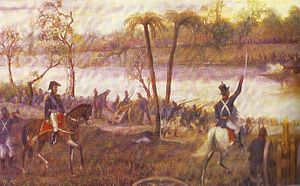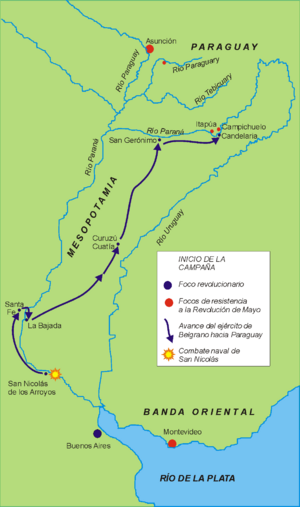Paraguay campaign facts for kids
Quick facts for kids Paraguay Campaign |
|||||||
|---|---|---|---|---|---|---|---|
| Part of the Spanish American wars of independence | |||||||
 Argentine forces crossing the Paraná River |
|||||||
|
|||||||
| Belligerents | |||||||
| United Provinces | |||||||
| Commanders and leaders | |||||||
| Manuel Belgrano | |||||||
| Strength | |||||||
| Around 1,000-2,000 | Spanish troops: ~1,500 Paraguayan patriots: ~3,500 |
||||||
| Casualties and losses | |||||||
| Around 500-1,000 men (killed, wounded and prisoners) | Around 500-1,000 men (killed, wounded and prisoners) | ||||||
The Paraguay campaign (1810–1811) was a military effort by Buenos Aires to bring Paraguay into its new government. This happened during the Argentine War of Independence. The campaign was led by Manuel Belgrano, a famous Argentine general.
For Paraguay, this campaign is seen as their own War of Independence. The first fights were the Battle of Campichuelo and Battle of Campo Maracana. Buenos Aires claimed victory in these. However, Belgrano's forces were later defeated in the Battle of Paraguarí and the Battle of Tacuarí. The campaign ended in a military failure for Buenos Aires. Soon after, Paraguay broke its ties with the Spanish crown and began its journey to full independence.
Contents
Why the Campaign Started
Three months after the Primera Junta (the new government in Buenos Aires) was formed, Manuel Belgrano was chosen to lead an army. His main goal was to get support from different areas, especially Paraguay. The leaders in Buenos Aires thought many people in Paraguay would support them. They believed a small army would be enough to take control.
Belgrano set off with about 200 men. He expected to gather more soldiers as he traveled towards the Paraná River. Soldiers from local regiments joined him along the way. Buenos Aires also sent more troops. The army grew to nearly 950 men. They had infantry (soldiers on foot), cavalry (soldiers on horseback), and artillery (cannons).
Paraguay's Own Path to Freedom
Paraguay was quite isolated from other parts of the Viceroyalty of the Río de la Plata. This meant that ideas of local independence were strong there. Paraguay's journey to independence began at a meeting on July 24, 1810. This meeting was called by the Spanish governor. He wanted Paraguay to stay loyal to the King of Spain.
Paraguayans refused to join the new government in Buenos Aires. They agreed to stay loyal to the King of Spain. But at the same time, many Paraguayans, led by José Gaspar Rodríguez de Francia, started working for their own independence. They wanted to be free from both Buenos Aires and Spain. Belgrano did not know about these strong feelings for independence when he invaded Paraguay. He thought he would find people ready to join Buenos Aires.
The Military Campaign
By the end of October, Belgrano's army stopped at Curuzú Cuatiá. Here, he helped solve an old border problem. He also organized the towns they passed through. In November 1810, the army reached the Paraná River. Belgrano made rules to help the native people living in missions. He gave them full civil and political rights. He also granted them land and allowed them to trade.
From there, the army moved to Candelaria. This place was used as a base for attacking Paraguay. The land gave an advantage to the Paraguayan troops led by Velazco. The Paraná River was very wide, about 1,000 meters. It was a strong natural barrier. After crossing it, Belgrano's army would have to march a long way without supplies. Swamps, hills, and rivers would make their march slow and a retreat difficult.
Belgrano's troops crossed the Paraná River on December 19. They used several boats. A small group of 54 Paraguayan soldiers had to run away during the battle of Campichuelo.
Battle of Paraguarí
Belgrano saw Velazco's army from a hill. Even though he was greatly outnumbered, he ordered an attack. He trusted in his soldiers' courage. When the battle of Paraguarí began, Belgrano's troops had an early advantage. But Velazco's larger army soon took control. This was thanks to about 3,500 Paraguayan patriots who joined the fight. The combined Paraguayan forces were much larger than Belgrano's. Belgrano's army lost ten men and 120 were captured. Belgrano wanted to keep fighting, but his officers convinced him to retreat. He knew his troops were better armed, even if they were fewer in number.
Battle of Tacuarí
Belgrano's army headed for Tacuarí. They were closely watched by the armies of Fulgencio Yegros and Manuel Atanasio Cabañas. These two armies had nearly 3,000 troops. Belgrano was left with only about 400 men. They were attacked from many sides during the Battle of Tacuarí on March 9.
Belgrano's small army was greatly outnumbered and losing the fight. He was asked to surrender, but he refused. He reorganized his remaining 235 men. He ordered his secretary to burn all his important papers. This was to stop them from falling into enemy hands. He made his troops and cannons fire constantly. This forced the Paraguayan troops to spread out. When the firing stopped, he asked for a ceasefire. He told Cabañas that he came to Paraguay to help, not to conquer. But since he found hostility, he would leave. Cabañas agreed, as long as Belgrano's army left Paraguay within a day.
What Happened Next
The Paraguay campaign was a complete military defeat for Buenos Aires. For the Paraguayans, Belgrano's defeat was a big step. It led to their independence from Buenos Aires. It also helped them gain freedom from Spain. Both Paraguayans and Argentines agree that Belgrano's actions were very important. They helped Paraguay become truly independent from Spain. However, in doing so, Paraguay also separated from Buenos Aires. They remained friends, but they were no longer part of the same political group.
See also
 In Spanish: Expedición de Belgrano al Paraguay para niños
In Spanish: Expedición de Belgrano al Paraguay para niños



